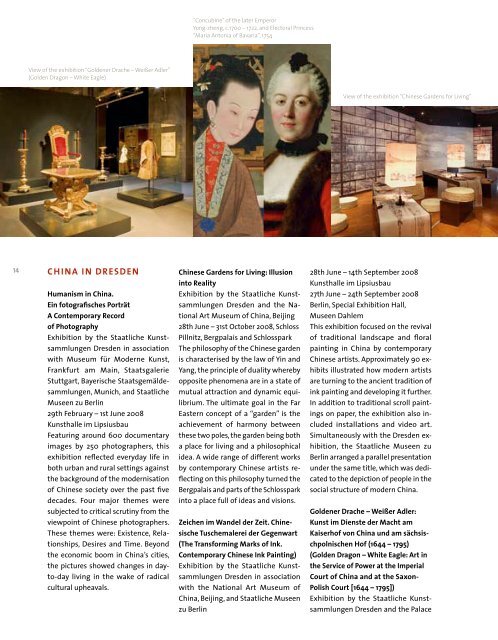2008 - Staatliche Kunstsammlungen Dresden
2008 - Staatliche Kunstsammlungen Dresden
2008 - Staatliche Kunstsammlungen Dresden
Create successful ePaper yourself
Turn your PDF publications into a flip-book with our unique Google optimized e-Paper software.
View of the exhibition “Goldener Drache – Weißer Adler”<br />
(Golden Dragon – White Eagle)<br />
14 ChiNA iN DREsDEN<br />
humanism in China.<br />
Ein fotografisches Porträt<br />
A Contemporary Record<br />
of Photography<br />
Exhibition by the <strong>Staatliche</strong> <strong>Kunstsammlungen</strong><br />
<strong>Dresden</strong> in association<br />
with Museum für Moderne Kunst,<br />
Frankfurt am Main, Staatsgalerie<br />
Stuttgart, Bayerische Staatsgemäldesammlungen,<br />
Munich, and <strong>Staatliche</strong><br />
Museen zu Berlin<br />
29th February – 1st June <strong>2008</strong><br />
Kunsthalle im Lipsiusbau<br />
Featuring around 600 documentary<br />
images by 250 photographers, this<br />
exhibition reflected everyday life in<br />
both urban and rural settings against<br />
the background of the modernisation<br />
of Chinese society over the past five<br />
decades. Four major themes were<br />
subjected to critical scrutiny from the<br />
viewpoint of Chinese photographers.<br />
These themes were: Existence, Relationships,<br />
Desires and Time. Beyond<br />
the economic boom in China’s cities,<br />
the pictures showed changes in dayto-day<br />
living in the wake of radical<br />
cultural upheavals.<br />
“Concubine” of the later Emperor<br />
Yong-zheng, c.1700 – 1722, and Electoral Princess<br />
“Maria Antonia of Bavaria”, 1754<br />
Chinese gardens for Living: illusion<br />
into Reality<br />
Exhibition by the <strong>Staatliche</strong> <strong>Kunstsammlungen</strong><br />
<strong>Dresden</strong> and the National<br />
Art Museum of China, Beijing<br />
28th June – 31st October <strong>2008</strong>, Schloss<br />
Pillnitz, Bergpalais and Schlosspark<br />
The philosophy of the Chinese garden<br />
is characterised by the law of Yin and<br />
Yang, the principle of duality whereby<br />
opposite phenomena are in a state of<br />
mutual attraction and dynamic equilibrium.<br />
The ultimate goal in the Far<br />
Eastern concept of a “garden” is the<br />
achievement of harmony between<br />
these two poles, the garden being both<br />
a place for living and a philosophical<br />
idea. A wide range of different works<br />
by contemporary Chinese artists reflecting<br />
on this philosophy turned the<br />
Bergpalais and parts of the Schlosspark<br />
into a place full of ideas and visions.<br />
Zeichen im Wandel der Zeit. Chinesische<br />
Tuschemalerei der gegenwart<br />
(The Transforming marks of ink.<br />
Contemporary Chinese ink Painting)<br />
Exhibition by the <strong>Staatliche</strong> <strong>Kunstsammlungen</strong><br />
<strong>Dresden</strong> in association<br />
with the National Art Museum of<br />
China, Beijing, and <strong>Staatliche</strong> Museen<br />
zu Berlin<br />
View of the exhibition “Chinese Gardens for Living”<br />
28th June – 14th September <strong>2008</strong><br />
Kunsthalle im Lipsiusbau<br />
27th June – 24th September <strong>2008</strong><br />
Berlin, Special Exhibition Hall,<br />
Museen Dahlem<br />
This exhibition focused on the revival<br />
of traditional landscape and floral<br />
painting in China by contemporary<br />
Chinese artists. Approximately 90 exhibits<br />
illustrated how modern artists<br />
are turning to the ancient tradition of<br />
ink painting and developing it further.<br />
In addition to traditional scroll paintings<br />
on paper, the exhibition also included<br />
installations and video art.<br />
Simultaneously with the <strong>Dresden</strong> exhibition,<br />
the <strong>Staatliche</strong> Museen zu<br />
Berlin arranged a parallel presentation<br />
under the same title, which was dedicated<br />
to the depiction of people in the<br />
social structure of modern China.<br />
goldener Drache – Weißer Adler:<br />
kunst im Dienste der macht am<br />
kaiserhof von China und am sächsischpolnischen<br />
hof (1644 – 1795)<br />
(golden Dragon – White Eagle: Art in<br />
the service of Power at the imperial<br />
Court of China and at the saxon-<br />
Polish Court [1644 – 1795])<br />
Exhibition by the <strong>Staatliche</strong> <strong>Kunstsammlungen</strong><br />
<strong>Dresden</strong> and the Palace

















